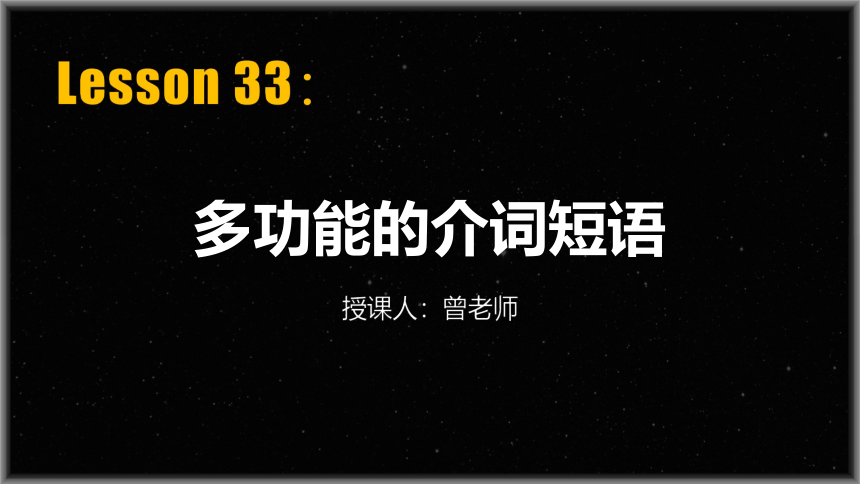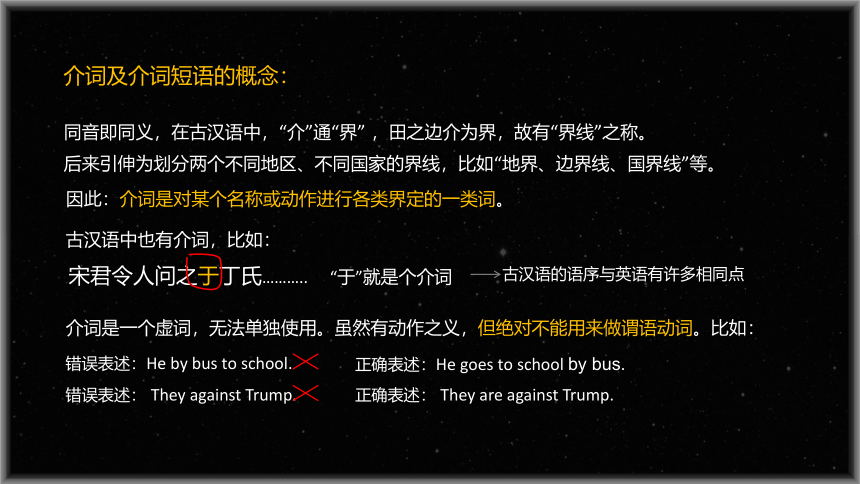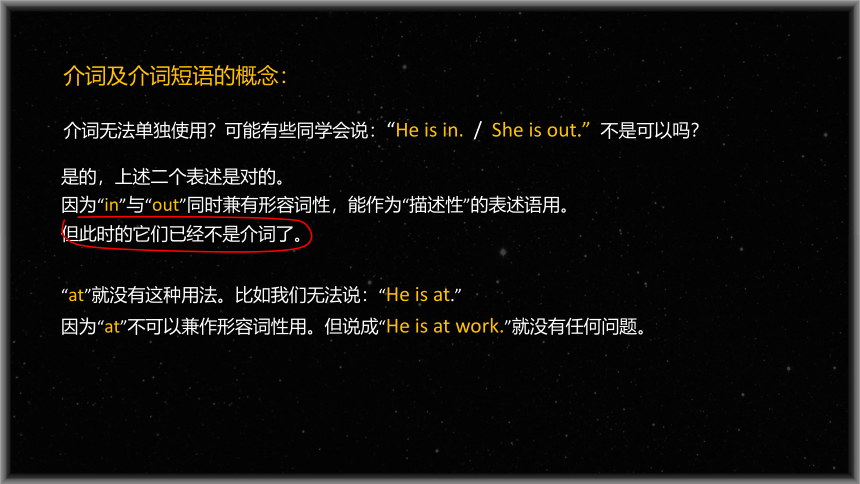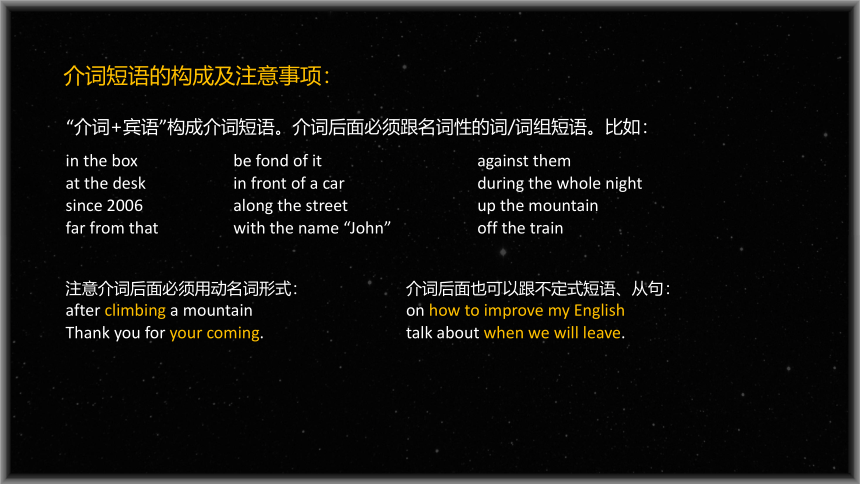L33-多功能的介词短语 初中英语词性句法新讲课件
文档属性
| 名称 | L33-多功能的介词短语 初中英语词性句法新讲课件 |  | |
| 格式 | ppt | ||
| 文件大小 | 1002.5KB | ||
| 资源类型 | 试卷 | ||
| 版本资源 | 通用版 | ||
| 科目 | 英语 | ||
| 更新时间 | 2022-04-11 09:59:44 | ||
图片预览






文档简介
(共13张PPT)
多功能的介词短语
Lesson 33:
授课人:曾老师
同音即同义,在古汉语中,“介”通“界” ,田之边介为界,故有“界线”之称。
后来引伸为划分两个不同地区、不同国家的界线,比如“地界、边界线、国界线”等。
介词及介词短语的概念:
介词是一个虚词,无法单独使用。虽然有动作之义,但绝对不能用来做谓语动词。比如:
古汉语的语序与英语有许多相同点
宋君令人问之于丁氏………..
“于”就是个介词
错误表述: They against Trump.
正确表述: They are against Trump.
错误表述:He by bus to school.
正确表述:He goes to school by bus.
因此:介词是对某个名称或动作进行各类界定的一类词。
古汉语中也有介词,比如:
介词无法单独使用?可能有些同学会说:“He is in. / She is out.” 不是可以吗?
介词及介词短语的概念:
“at”就没有这种用法。比如我们无法说:“He is at.”
因为“at”不可以兼作形容词性用。但说成“He is at work.”就没有任何问题。
是的,上述二个表述是对的。
因为“in”与“out”同时兼有形容词性,能作为“描述性”的表述语用。
但此时的它们已经不是介词了。
介词及介词短语的二大主要作用:
1. 用来修饰或描述名称词时:
表明二个物体之间的时空关系,或用另一个名称词来说明一个名称词的各种情况,包括:
方式/方法、来因/缘由、原因/结果、目标/去向等。
2. 用来描述说明一个动作词时:
用来说明动作发生的时间/地点、方式/方法、来因/缘由、原因/结果、目标/去向等。
介词短语的构成及注意事项:
“介词+宾语”构成介词短语。介词后面必须跟名词性的词/词组短语。比如:
in the box
at the desk
since 2006
far from that
be fond of it
in front of a car
along the street
with the name “John”
against them
during the whole night
up the mountain
off the train
注意介词后面必须用动名词形式:
after climbing a mountain
Thank you for your coming.
介词后面也可以跟不定式短语、从句:
on how to improve my English
talk about when we will leave.
介词短语的构成及注意事项:
▲宾语如果是人称代词,一定要用宾体格形式(只有6个)。如下:
with me
to him
for her
by us
without them
Is this the man to whom you wrote the letter
介词短语的词性及句法功能:
▲ 但是:
它不具有名称性,所以一般不可以作主语或宾语;除非将其看作一个名称。
也不具有动作词性,不可以用作谓语。
1. 用来修饰或描述名称词时: 充当定语、表述语、补足语
2. 用来描述说明动作词时: 充当状语
1. 介词短语作定语:
a girl in red
two cars ahead of me
trees along the street
a boy with the name “John”
people in hurry
my way to the station
a plan for solving this problem
介词短语修饰限定名称词时必须后置。比如:
an answer to the question
the key to success
the park near our school
a trip to Hongkong
a boy with a flower in his hand
some students from America
a government by the people, of the people, and for the people
详情请阅:L36-名称短语的构成
2. 介词短语作表述语:
They are from Korea.
I am to Beijing.
Your parents are for you.
Who was by air
The passengers are off the train.
This novel is by Shakespear.
Our manager is on holiday in the south.
Tom is with his parents now.
This war is against the cancer.
That’s all because of the storm.
Mary gets into trouble these days.
I wish your dreams will turn into real.
介词短语作表述语时跟系动词或系动动词搭配。比如:
他们来自于韩国。
我这是去北京。
你父母亲就是为了你。
谁是坐飞机的?
乘客们现已下火车。
这部小说是莎士比亚写的。
我们的经理在南方度假。
汤姆跟他的父母亲在一起。
这场战争是针对癌症的。
那都是因为这场暴风雨。
玛丽这些天陷入麻烦了。
我希望你的这些梦想能够变成现实。
3. 介词短语作补充说明性表述语:
When she woke up, she found herself in the hospital.
Many people always refer to him as a bookworm(书呆子).
She is elected as the monitor of our class.
介词短语作表述语时,一样可以用作宾语或主语的补充说明语。比如:
▲ 成分的双重性:不管将它看作是什么成分,句子意思基本相同。比如:
They finally found their son in a cave. 作宾补
They finally found their son in a cave. 作状语
4. 介词短语作状语:
live in a small village
run after the dog
play with the children
Listen to music
Walk to school
learn theory without practice.
live in an apartment.
prevent us from completing the work.
介词短语作状语,用来说明动作词的各种情况。比如:
He works in the factory.
She got here at four.
They came here by train.
I was sleeping under a tree.
The game was postponed because of rain.
I go there every day.
She looked at me in surprise.
They are fighting against the flood.
副词与介词短语的区别:
… go home
… go to my home
5. 介词的种类及功能:
5. 目标方向
6. 目的起因
7. 数量额度
8. 伴随一起
09. 涉及内容
10. 节奏频率
11. 条件假设
12. 顺序排位
13. 让步退让
14. 工具渠道
15. 姿势轨迹
16. 意义结果
17. 相似类同
18. 赞成反对
19. 替代替换
20. 状态情况
介词短语至少可以用来界定说明20种情况:
1. 时间关系
2. 空间关系
3. 方式方法
4. 对象内容
6. 特殊情况下,介词短语的名称属性:
come from across the street
until after dinner
people from below the mountain turn to for sth.
look at the room from up there
在特殊的情况下,部分介词短语当作名称性词用。比如:
从街对面来 = come from somewhere across the street.
一直到晚饭后 = until the time after dinner
来自于山下的人们 = people from the village below ...
转过来寻求帮助 = turn to sb. for sth.
Robotic technology is moving out from behind factory walls.
机器人技术正从工厂墙内走向墙外(言下之意为:正进入应用阶段)
(待续)
多功能的介词短语
Lesson 33:
授课人:曾老师
同音即同义,在古汉语中,“介”通“界” ,田之边介为界,故有“界线”之称。
后来引伸为划分两个不同地区、不同国家的界线,比如“地界、边界线、国界线”等。
介词及介词短语的概念:
介词是一个虚词,无法单独使用。虽然有动作之义,但绝对不能用来做谓语动词。比如:
古汉语的语序与英语有许多相同点
宋君令人问之于丁氏………..
“于”就是个介词
错误表述: They against Trump.
正确表述: They are against Trump.
错误表述:He by bus to school.
正确表述:He goes to school by bus.
因此:介词是对某个名称或动作进行各类界定的一类词。
古汉语中也有介词,比如:
介词无法单独使用?可能有些同学会说:“He is in. / She is out.” 不是可以吗?
介词及介词短语的概念:
“at”就没有这种用法。比如我们无法说:“He is at.”
因为“at”不可以兼作形容词性用。但说成“He is at work.”就没有任何问题。
是的,上述二个表述是对的。
因为“in”与“out”同时兼有形容词性,能作为“描述性”的表述语用。
但此时的它们已经不是介词了。
介词及介词短语的二大主要作用:
1. 用来修饰或描述名称词时:
表明二个物体之间的时空关系,或用另一个名称词来说明一个名称词的各种情况,包括:
方式/方法、来因/缘由、原因/结果、目标/去向等。
2. 用来描述说明一个动作词时:
用来说明动作发生的时间/地点、方式/方法、来因/缘由、原因/结果、目标/去向等。
介词短语的构成及注意事项:
“介词+宾语”构成介词短语。介词后面必须跟名词性的词/词组短语。比如:
in the box
at the desk
since 2006
far from that
be fond of it
in front of a car
along the street
with the name “John”
against them
during the whole night
up the mountain
off the train
注意介词后面必须用动名词形式:
after climbing a mountain
Thank you for your coming.
介词后面也可以跟不定式短语、从句:
on how to improve my English
talk about when we will leave.
介词短语的构成及注意事项:
▲宾语如果是人称代词,一定要用宾体格形式(只有6个)。如下:
with me
to him
for her
by us
without them
Is this the man to whom you wrote the letter
介词短语的词性及句法功能:
▲ 但是:
它不具有名称性,所以一般不可以作主语或宾语;除非将其看作一个名称。
也不具有动作词性,不可以用作谓语。
1. 用来修饰或描述名称词时: 充当定语、表述语、补足语
2. 用来描述说明动作词时: 充当状语
1. 介词短语作定语:
a girl in red
two cars ahead of me
trees along the street
a boy with the name “John”
people in hurry
my way to the station
a plan for solving this problem
介词短语修饰限定名称词时必须后置。比如:
an answer to the question
the key to success
the park near our school
a trip to Hongkong
a boy with a flower in his hand
some students from America
a government by the people, of the people, and for the people
详情请阅:L36-名称短语的构成
2. 介词短语作表述语:
They are from Korea.
I am to Beijing.
Your parents are for you.
Who was by air
The passengers are off the train.
This novel is by Shakespear.
Our manager is on holiday in the south.
Tom is with his parents now.
This war is against the cancer.
That’s all because of the storm.
Mary gets into trouble these days.
I wish your dreams will turn into real.
介词短语作表述语时跟系动词或系动动词搭配。比如:
他们来自于韩国。
我这是去北京。
你父母亲就是为了你。
谁是坐飞机的?
乘客们现已下火车。
这部小说是莎士比亚写的。
我们的经理在南方度假。
汤姆跟他的父母亲在一起。
这场战争是针对癌症的。
那都是因为这场暴风雨。
玛丽这些天陷入麻烦了。
我希望你的这些梦想能够变成现实。
3. 介词短语作补充说明性表述语:
When she woke up, she found herself in the hospital.
Many people always refer to him as a bookworm(书呆子).
She is elected as the monitor of our class.
介词短语作表述语时,一样可以用作宾语或主语的补充说明语。比如:
▲ 成分的双重性:不管将它看作是什么成分,句子意思基本相同。比如:
They finally found their son in a cave. 作宾补
They finally found their son in a cave. 作状语
4. 介词短语作状语:
live in a small village
run after the dog
play with the children
Listen to music
Walk to school
learn theory without practice.
live in an apartment.
prevent us from completing the work.
介词短语作状语,用来说明动作词的各种情况。比如:
He works in the factory.
She got here at four.
They came here by train.
I was sleeping under a tree.
The game was postponed because of rain.
I go there every day.
She looked at me in surprise.
They are fighting against the flood.
副词与介词短语的区别:
… go home
… go to my home
5. 介词的种类及功能:
5. 目标方向
6. 目的起因
7. 数量额度
8. 伴随一起
09. 涉及内容
10. 节奏频率
11. 条件假设
12. 顺序排位
13. 让步退让
14. 工具渠道
15. 姿势轨迹
16. 意义结果
17. 相似类同
18. 赞成反对
19. 替代替换
20. 状态情况
介词短语至少可以用来界定说明20种情况:
1. 时间关系
2. 空间关系
3. 方式方法
4. 对象内容
6. 特殊情况下,介词短语的名称属性:
come from across the street
until after dinner
people from below the mountain turn to for sth.
look at the room from up there
在特殊的情况下,部分介词短语当作名称性词用。比如:
从街对面来 = come from somewhere across the street.
一直到晚饭后 = until the time after dinner
来自于山下的人们 = people from the village below ...
转过来寻求帮助 = turn to sb. for sth.
Robotic technology is moving out from behind factory walls.
机器人技术正从工厂墙内走向墙外(言下之意为:正进入应用阶段)
(待续)
同课章节目录
- 词法
- 名词
- 动词和动词短语
- 动词语态
- 动词时态
- 助动词和情态动词
- 非谓语动词
- 冠词
- 代词
- 数词和量词
- 形容词副词及其比较等级
- 介词和介词短语
- 连词和感叹词
- 构词法
- 相似、相近词比较
- 句法
- 陈述句
- 一般疑问句和否定疑问句
- 特殊疑问句及选择疑问句
- 反意疑问句
- 存在句(There be句型)
- 宾语从句
- 定语从句
- 状语从句
- 主谓一致问题
- 简单句
- 并列句
- 复合句
- 主谓一致
- 主、表语从句
- 名词性从句
- 直接引语和间接引语
- 虚拟语气
- 感叹句
- 强调句
- 倒装句
- 祈使句
- 句子的成分
- 句子的分类
- 题型专区
- 单项选择部分
- 易错题
- 完形填空
- 阅读理解
- 词汇练习
- 听说训练
- 句型转换
- 补全对话
- 短文改错
- 翻译
- 书面表达
- 任务型阅读
- 语法填空
- 其他资料
